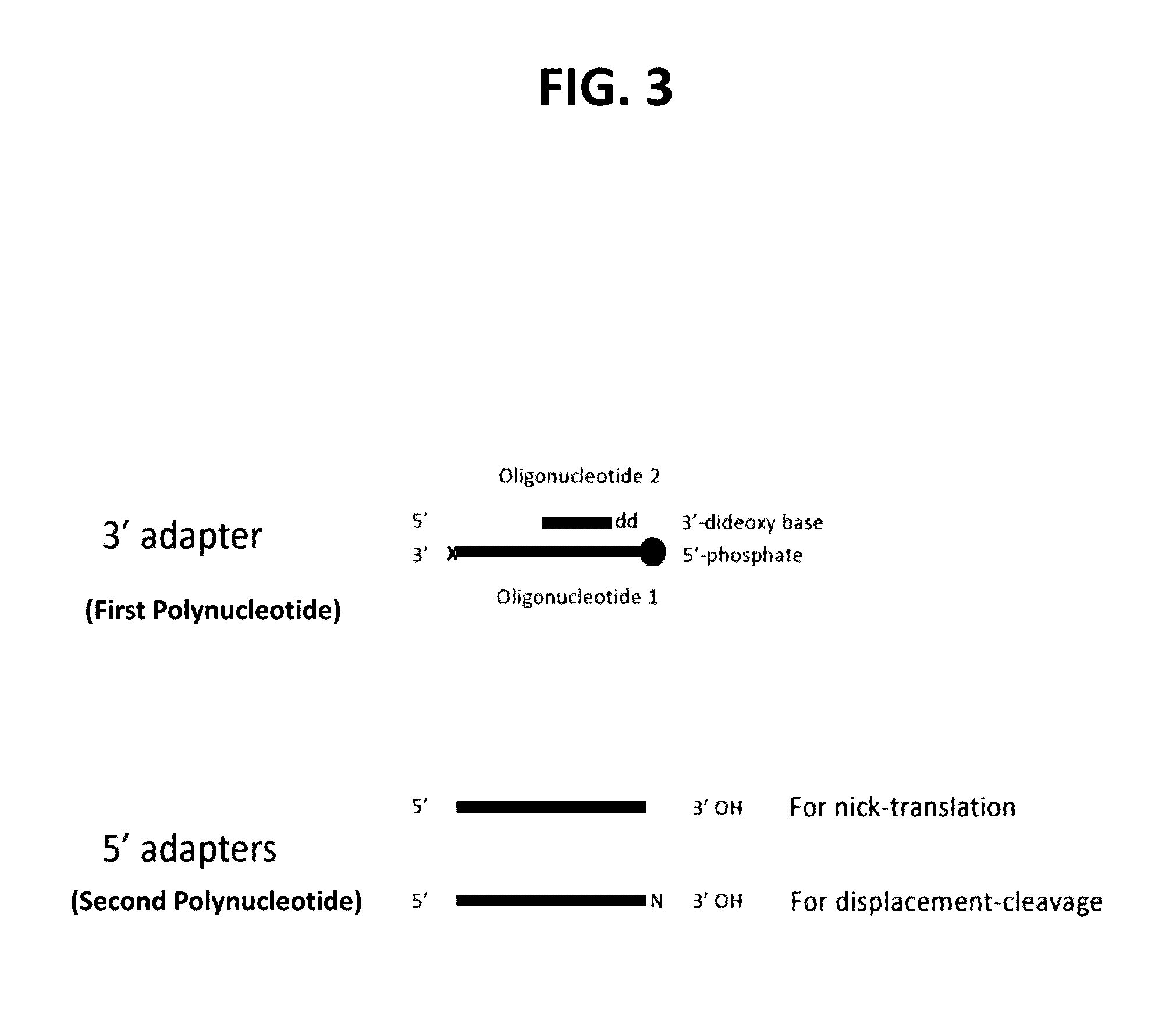Methods for processing DNA substrates
- Summary
- Abstract
- Description
- Claims
- Application Information
AI Technical Summary
Benefits of technology
Problems solved by technology
Method used
Image
Examples
example 1
Comparison of Conventional Adapter Ligation to 3′ Adapter Ligation with FAM-Labeled Oligonucleotides
[0216]Rationale: Using a FAM-labeled oligonucleotide system, blunt ligation using fill-in adapters (FIG. 2A) or 3′ adapters (FIG. 3) was tested at different molar ratios of substrate to adapter to examine the effect on ligation efficiency and chimera formation.
[0217]Materials:[0218]Fill-in adapter contains oligonucleotides 12-900 and 13-426 (Table 1)[0219]3′Adapter; 1st oligonucleotide 13-340 (Table 1)[0220]3′Adapter; 2nd oligonucleotide option 1 (with a blocking 3′ deoxythymidine base at the 3′ terminus) 13-559 (Table 1)[0221]3′Adapter; 2nd oligonucleotide option 2 (a phosphate group at the 3′ terminus) 13-558 (Table 1)[0222]FAM substrate A composed of oligonucleotides 13-562 and 13-563, where the FAM group labels ligation to the 5′ Phosphate of the substrate (Table 1)[0223]FAM substrate B composed of oligonucleotides 13-561 and 13-564, where the FAM group labels ligation to the 3′ O...
example 2
Comparison of Conventional Adapter Ligation to 3′ Adapter Ligation with Sheared, Size-Selected Genomic DNA
[0234]Rationale: This experiment was performed to test the effect of polishing of physically sheared genomic DNA on the efficiency of conventional or 3′ adapter ligation
[0235]Materials:[0236]Fill-in adapter contains oligonucleotides 13-489 and 13-426 (Table 1)[0237]3′Adapter; 1st oligonucleotide 13-340 (Table 1) and 2nd oligonucleotide option 1 (containing a blocking3′ deoxythymidine base at the 3′ terminus) 13-559 (Table 1)[0238]NEBuffer 2 (New England Biolabs, cat#B7002S)[0239]100 mM 2′-deoxynucleoside 5′-triphosphate (dNTP) Set, PCR Grade (Invitrogen (Life technologies), cat# 10297-018)[0240]Adenosine 5′-Triphosphate (ATP) (New England Biolabs, cat# P0756S)[0241]DNA Polymerase I, Large (Klenow) Fragment (New England Biolabs, cat# M0210S)[0242]T4 DNA polymerase (New England Biolabs, cat# M0203S)[0243]T4 Polynucleotide Kinase (New England Biolabs, cat# M0201S)[0244]Exonuclease ...
example 3
Temperature Optimization for 5′ Adapter Ligation using a FAM-Labeled Oligonucleotide Substrate
[0259]Rationale: This experiment assessed the temperature dependence and dNTP composition on nick translation mediated 5′ adapter ligation.
[0260]Materials:[0261]5′ adapter oligonucleotide for nick-translation (13-144) (Table 1)[0262]FAM oligonucleotide substrate (13-581) (Table 1)[0263]Oligonucleotide template (13-582) (Table 1)[0264]100 mM 2′-deoxynucleoside 5′-triphosphate (dNTP) Set, PCR Grade (Invitrogen (Life technologies), cat# 10297-018)[0265]E. coli DNA ligase (New England BioLabs, cat# M0205S)[0266]10X E. coli DNA Ligase Reaction Buffer (New England BioLabs)[0267]Taq DNA polymerase, concentrated 25U / ul (Genscript, cat# E00012)[0268]25 by ladder DNA size marker (Invitrogen (Life technologies), cat# 10488-022)
Method
[0269]A first set of nick translation reactions was assembled in a total volume of 30 μl, comprising a final concentration of 1×E. coli DNA ligase Buffer, 30 pmoles of FAM...
PUM
| Property | Measurement | Unit |
|---|---|---|
| Temperature | aaaaa | aaaaa |
| Temperature | aaaaa | aaaaa |
| Temperature | aaaaa | aaaaa |
Abstract
Description
Claims
Application Information
 Login to View More
Login to View More - R&D
- Intellectual Property
- Life Sciences
- Materials
- Tech Scout
- Unparalleled Data Quality
- Higher Quality Content
- 60% Fewer Hallucinations
Browse by: Latest US Patents, China's latest patents, Technical Efficacy Thesaurus, Application Domain, Technology Topic, Popular Technical Reports.
© 2025 PatSnap. All rights reserved.Legal|Privacy policy|Modern Slavery Act Transparency Statement|Sitemap|About US| Contact US: help@patsnap.com



